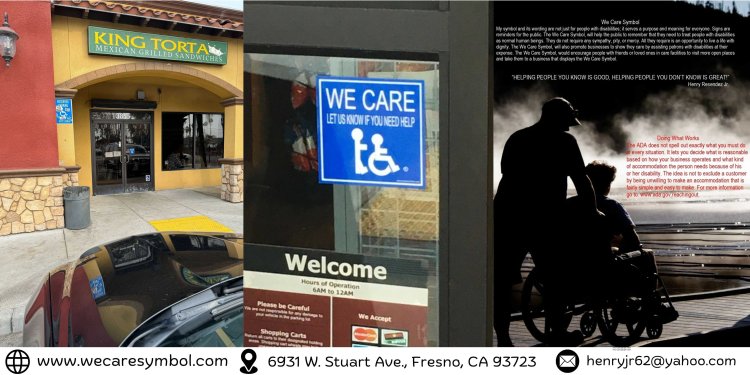Places where the Disabilities symbol is a must-sign to use
Important information about the accessibility of facilities and programs for any disabled person is recognizable by the Disabilities symbol. In such cases, the most widely used and recognizable symbol for accessibility is the International Sign of Accessibility (ISA). It is the well-known Handicap wheelchair logo. Regrettably, the Handicapped wheelchair sign, along with other global accessibility symbols, is occasionally abused. In this post, you are going to learn about a few important places where a handicap wheelchair sign is necessary.

What is a disability symbol?
The worldwide symbol for disability is a white image of a person using a wheelchair on a blue backdrop. The International Sign of Access (ISA) may be found on restroom doors, painted on parking spaces, and displayed on signs for public transportation. It signifies that an establishment is exclusively or completely accessible to people with disabilities.
However, is this wheelchair-using symbol inclusive? This year marks the 50th anniversary of the emblem. It was created in 1968. Many individuals believe it should be changed to represent those with "invisible disabilities." For those who do not use wheelchairs and whose conditions are discrete or invisible.
The conditions under which the ISA, along with other symbols, should be used are outlined in the ADA/ABA Accessibility Guidelines.
The UFAS or ADAAG have mandated that the ISA be posted in just several locations:
-
Parking spots that are accessible
-
Restrooms that are accessible
-
Loading zones that are accessible
-
accessible building entrances if the main one is inaccessible
As part of the Nationwide renewal procedure, you are required to renew your mobility symbol license plates annually. Starting August 1, 2013, in order to renew wheelchair symbol license plates, you will need to undergo a medical recertification every three years.
You must turn in your Person with a Disabilities Identification Card and wheelchair signal plates and apply using a new set of ordinary registration plates at an automobile agency if you are no longer eligible for them.
Loading zones and parking spots that are accessible
Posting a sign with the disability in highly contrasted colors at each accessible parking area is the only legal obligation. The van-accessible parking place sign has to have the word "van" on it. It is improper to use the phrase "handicapped" on signs indicating loading zones or parking lots.
The placement of blue-and-white signage in loading zones or accessible parking spots on Federal properties is required by law for land management agencies. There are also orders to match the signage seamlessly with Forest Service signage; signs with the ISA may be blue, featuring a cream or yellow emblem and writing.
Bathrooms
At all accessible restrooms, the Disabilities symbol, as well as gender identification, must be displayed 60 inches from the floor on the wall next to the latching side of the door. For details on colors, symbols, and individuals, including raised or Braille letters and numerals, refer to section 703 of the ADA/ABA Accessibility Guidelines.
Logo of the Disabilities symbol Entrance Signs featuring a person in a wheelchair
To show that every institution satisfies the UFAS or ADAAG, the ISA might be displayed on the facility's main entrance sign. You risk having disgruntled consumers if you utilize the ISA on an entrance sign for any facility that does not fully comply with the Federal accessibility criteria. Watch out for the disabilities symbol.
Adaptive Services and Equipment
When services like signs, interpreters, assistive listening devices, or teletypewriters are available, it's frequently beneficial to publish the relevant international symbols.
Paths
In addition to the usual statement with the title, number, destination, and distance, display the following details on pedestrian paths where accessibility has been assessed:
-
Normal and ideal trail grades
-
Trail width minimum
-
The normal and maximum cross slopes
-
Trail surface (surface type and stiffness)
-
Any significant obstruction, like rocks in the trail's tread
Updates to terminology and accessibility guidelines
-
The word "handicapped" should never be used on signs for parking or any other type of signage. For a definition of why this word is inappropriate, go to the sections on vocabulary and accessibility status.
-
The 1993 book Universal Access to Outside Recreation, A Technical Guide, contains three levels of difficulty: difficult, easy, and moderate. Do Not obey these signs.
-
The 1999 Draft Outdoor Recreation Developed Areas accessibility guidelines should not be followed. Specifically, avoid posting the ISA at any accessible campground.
-
Do abide by the signage recommendations in the proposed Forest Service accessibility standards for trails and outdoor activities. You can utilize the most recent draft versions and track the development process.
Conclusion
These are the places where using the Handicap wheelchair symbol is essential. If you have property accessible to the general public, you must use this symbol. This will help all specially
What's Your Reaction?


















.jpg)
.jpg)


